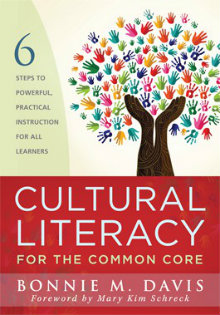6 Steps to Cultural Literacy for All Learners
Cultural Literacy for the Common Core: 6 Steps to Powerful, Practical Instruction for All Learners
By Bonnie M. Davis
(Solution Tree, 2014 – Learn more)

As a budding researcher interested in issues of equity and diversity, I was excited to see Cultural Literacy for the Common Core: 6 Steps to Powerful, Practical Instruction for All Learners on the MiddleWeb reading list. Not only was I interested in reading more about cultural literacy, but I was eager to learn how the author connected the Common Core.
In many ways this book met my expectations. It is full of practical advice and examples of practices that promote cultural literacy. However, I was disappointed to discover that the authors only addressed the English Language Arts (ELA) portion of the Common Core. Nevertheless, it provides a lot of valuable information that can be adapted for any content and any grade level.
An in-depth look at each step

Educators of all age groups can find valuable nuggets within the pages. At first glance, many of the practices appear to be geared towards elementary aged students. However, the author provides tips and suggestions for modifications that allow the activities or practices to be used across grade bands.
A resource for professional development
One of the best features of this book is that it is organized in such a way that teachers can easily use it as a focus for a book study. Each chapter is packed with references to the research Davis draws upon to support her claims. In addition to research connections, she includes reflection questions throughout the text. For both reasons, it would be ideal to use as a guide in a professional learning community or department setting.
My favorite chapters were the first and last chapters. Chapter 1 discusses building relationships. In combination with the usual suggestions, Davis provides suggestions about honoring visibility and voice. By honoring visibility and voice, teachers take strides towards developing culturally literate classrooms.
The final chapter is about embarking on a personal cultural literacy journey. Instead of leaving her readers with a vague sense of what that directive means, she provides several examples of real teachers engaging in the journey, as well as concrete strategies for anyone considering taking on the challenge. Again, she recommends taking the journey with a group.
Reservations
Not everything about this book receives my glowing recommendation. I was disappointed to find only ELA examples within its pages. The practices are general enough that it would have been nice to see some connection to the Common Core standards in mathematics, as well. The focus on cultural literacy should not be restricted to the ELA classroom. Despite the fact that examples were limited in that way, I believe that teachers of other content areas would still be able to adapt the suggestions to suit their individual classroom needs.
Additionally, some of the connections between suggested practices and cultural literacy were not always clear. I often found myself questioning how the author’s suggestion furthered her stated goal of becoming more culturally literate. At the end of each section she would wrap it up. At that point, the connection was made clear. In the moment though, it was difficult to always see the connection she was attempting to make. It occasionally felt like generic teaching advice rather than suggestions for building cultural literacy.
3 out of 5 stars
My overall rating for this book would be 3 out of 5 stars. The practical examples, along with chapters 1 and 6, make it worth the read but, depending on your content area and grade band, you may have to do a lot of modification in order to find the suggestions useful.
Ashley Walther is a secondary numeracy coach for a middle school in Knoxville, Tennessee. She is currently pursuing a Ph.D. in Mathematics Teacher Education at the University of Tennessee–Knoxville. She has experience teaching both middle and high school mathematics.

































